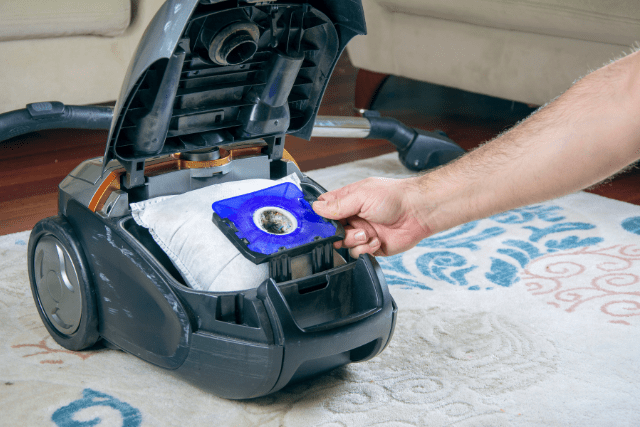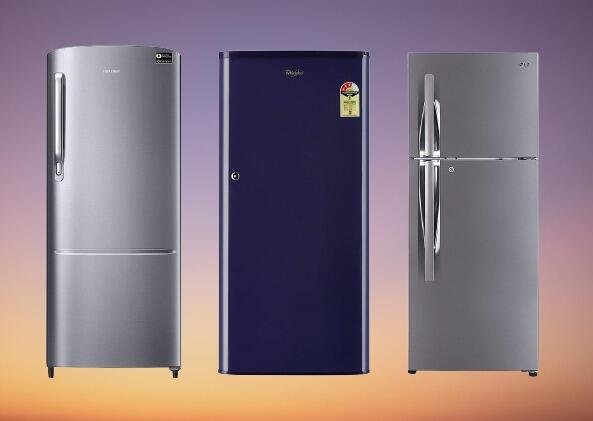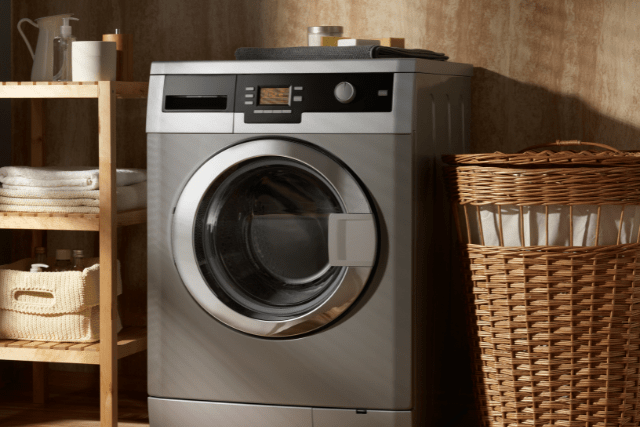Are you tired of lugging around a heavy vacuum cleaner that seems to do a poor job of picking up even the tiniest speck of dust?
Get ready to find out which vacuum cleaner is on top in the battle between bagged and bagless models. We’ll examine efficiency, maintenance, cost, allergen control, convenience, suction power, environmental impact, and longevity.
So, buckle up and get ready to learn the truth about these cleaning machines.
Key Takeaways
- Bagged vacuum cleaners offer consistent performance and effectively trap dust, dirt, and allergens.
- Bagless vacuum cleaners allow you to see when the canister needs emptying and eliminate the need for bag replacements.
- Bagged vacuum cleaners generally have a lower upfront cost but require the purchase of replacement bags.
- Bagless vacuum cleaners may release allergens back into the air during emptying and have a shorter lifespan.
Bagged vs Bagless Vacuums:
The decision between a bagged vacuum and a bagless vacuum cleaner often depends on personal preference and specific needs. Bagless vacuums offer the convenience of not replacing vacuum bags but may require more frequent filter cleaning. On the other hand, bagged vacuums may be more suitable for individuals with allergies as they minimize exposure to dust and debris while changing the bag.
Choosing Between Bagged and Bagless:
When selecting the right vacuum, consider the type that best suits your needs. Bagged and bagless vacuum cleaners have advantages and disadvantages, so it’s crucial to select one based on factors such as allergy sensitivity, the need for cordless vacuums, and ease of bag or bagless emptying.

Efficiency
When it comes to efficiency, bagged vacuum cleaners are often the top choice for homeowners. Why, you ask?
Well, it’s simple. Bagged vacuum cleaners are designed to maximize suction power and maintain consistent performance throughout the cleaning process.
Their high-quality filtration systems and sealed bags effectively trap dust, dirt, and allergens, preventing them from escaping into the air. This means cleaner, healthier indoor air for you and your family.
Unlike bagless vacuum cleaners, which rely on filters that require regular cleaning and maintenance, bagged vacuums offer a hassle-free solution. All you have to do is replace the bag when it’s full, ensuring optimal performance every time you clean. This saves you time and effort and helps prolong your vacuum cleaner’s life.
Also, bagged vacuum cleaners are known for their large capacity bags, allowing you to clean for longer periods without interruption. You won’t have to constantly empty the dirt canister or worry about it getting clogged, making your cleaning routine more efficient and seamless.
Maintenance
Regular maintenance ensures your vacuum cleaner’s longevity and optimal performance. Whether you have a bagged or bagless vacuum cleaner, taking care of it will extend its lifespan and keep it working efficiently.
Maintenance tasks may vary depending on the type of vacuum cleaner you own, but they are equally important.
For bagged vacuum cleaners, the first step is to check the bag’s fullness regularly. When the bag is around two-thirds full, it’s time to replace it. A full bag can reduce the suction power of your vacuum and make it less effective.
It’s crucial to clean or replace the filters regularly. Clogged filters can hinder the airflow, reducing the vacuum’s performance. Inspect the brushes and remove any tangled hair or debris to prevent them from getting stuck and affecting the vacuum’s efficiency.
Maintenance tasks are slightly different for bagless vacuum cleaners. Emptying the dust container after each use is crucial to prevent it from overflowing and clogging the vacuum.
Cleaning the filters regularly is important, as they can become dirty and affect the vacuum’s suction power. Some bagless models also have brush rolls that need to be cleaned to prevent them from getting tangled with hair or threads.
Cost
The cost of a vacuum cleaner can vary depending on whether you choose a bagged or bagless model. Regarding cost, bagged vacuum cleaners generally have a lower upfront price than their bagless counterparts.
Bagged vacuum cleaners typically require replacing bags, adding to the overall cost over time. On the other hand, bagless vacuum cleaners eliminate the need for bags, saving you money in the long run.
However, bagless models often require regular maintenance, such as cleaning and replacing filters, which can increase the cost over time.
Bagless vacuum cleaners may require more frequent emptying of the dust canister, which can be a hassle. It’s important to consider the cost of replacement bags or filters when deciding between a bagged or bagless vacuum cleaner.
Ultimately, the decision comes down to your personal preferences and budget. Whether you choose a bagged or bagless model, it’s crucial to weigh the upfront cost against long-term maintenance expenses to make an informed decision.

Allergen Control
Considering the cost of a vacuum cleaner, it’s important to consider how well it can control allergens in your home. Allergens, such as dust mites, pollen, and pet dander, can trigger allergies and respiratory issues, making it crucial to choose a vacuum cleaner that effectively removes these particles from your living space.
When comparing bagged and bagless vacuum cleaners, some key differences exist in their ability to control allergens. Let’s take a closer look at the pros and cons of each:
| Bagged Vacuum Cleaners | Bagless Vacuum Cleaners |
|---|---|
| Effective at trapping and containing allergens | May release allergens back into the air during emptying |
| Easy to dispose of the sealed bag without coming into contact with allergens | Emptying the dustbin can expose you to allergens |
| May require frequent bag changes, increasing maintenance costs | There is no need to purchase bags, reducing long-term expenses |
| Some models offer HEPA filtration, capturing even the tiniest allergens | HEPA filtration is available in select models, but not all |
Convenience
Bagged and bagless vacuum cleaners offer different levels of convenience for users. When considering which type to choose, it’s important to consider what will make your cleaning routine easier and more efficient. Here are some key factors to consider:
- Ease of disposal: Bagged vacuum cleaners are typically easier to empty and dispose of. All you have to do with a bag is remove it and throw it away. On the other hand, bagless vacuum cleaners require you to empty the dirt canister, which can be a messy task.
- Maintenance: Bagged vacuum cleaners often require less maintenance. Since the dirt and debris are contained in a bag, there is less chance of it clogging the filters or other parts of the vacuum. Bagless vacuum cleaners, on the other hand, require regular cleaning of the filters and canisters to ensure optimal performance.
- Cost: Bagged vacuum cleaners may have a higher upfront cost because you need to purchase bags regularly. Bagless vacuum cleaners, on the other hand, have a higher initial cost but don’t require ongoing purchases of bags. In the long run, bagless vacuum cleaners may be more cost-effective.
Consider these factors when deciding which type of vacuum cleaner will suit your needs best.
Suction Power
Regarding vacuum cleaners, suction power is a crucial factor for effective cleaning. A vacuum with strong suction power can efficiently remove dirt, dust, and debris from your floors and surfaces.
| Bagged Vacuum Cleaners | Bagless Vacuum Cleaners | |
|---|---|---|
| Suction Power | High | High |
| Maintenance | Regular replacement of bags | Emptying and cleaning the dirt canister |
| Allergens | Trapped inside the bag | Trapped inside the dirt canister |
| Filter Efficiency | This may decrease as the bag fills up | This may decrease as the canister fills up |
Bagged vacuum cleaners often have high suction power due to their design and the use of bags that help maintain consistent airflow. However, the suction power may decrease as the bag fills, requiring frequent bag replacements.
On the other hand, bagless vacuum cleaners also offer high suction power and allow you to see when the dirt canister needs emptying. While they eliminate the need for bag replacements, the maintenance involves emptying and cleaning the canister regularly.
Environmental Impact
Considering the impact on the environment is an important aspect when deciding between bagged and bagless vacuum cleaners. While both types of cleaners have their advantages, it is crucial to understand how they affect the environment.
- Waste management: Bagged vacuum cleaners require disposable bags that must be replaced regularly. These bags contribute to landfill waste, adding to the already mounting environmental concerns. On the other hand, bagless vacuum cleaners use reusable containers, reducing waste and minimizing their impact on the environment.
- Energy consumption: Bagged vacuum cleaners generally have higher energy consumption due to the need for constant suction power. This increased energy usage can harm the environment, contributing to higher carbon emissions. Bagless vacuum cleaners, on the other hand, often have more efficient motors, resulting in lower energy consumption and reduced environmental footprint.
- Air quality: Bagged vacuum cleaners typically have better air filtration systems as the bags are an additional filtration layer. This means they can trap smaller particles and allergens, producing cleaner air. However, bagless vacuum cleaners also have advanced filtration systems, such as HEPA filters, which can effectively remove allergens and pollutants from the air, ensuring a healthier living environment.
Considering these points, weighing the environmental impact when choosing between bagged and bagless vacuum cleaners is important.

Ultimately, opting for a bagless vacuum cleaner may help reduce waste, lower energy consumption, and maintain air quality, making it a more environmentally friendly choice.
Longevity
To ensure you get the most out of your vacuum cleaner, it’s important to consider the longevity of bagged and bagless options. While both types of vacuum cleaners have advantages and disadvantages, the device’s longevity is an important factor to consider when making your decision.
| Bagged Vacuum Cleaners | Bagless Vacuum Cleaners |
|---|---|
| Typically, they have a longer lifespan | Generally have a shorter lifespan |
| Bags must be replaced regularly, which can help extend the machine’s life. | There is less chance of dust and debris clogging the motor, which can prolong the life of the vacuum. |
| There is less chance of dust and debris clogging the motor, which can prolong the life of the vacuum | More prone to clogs, which can lead to decreased suction power and a shorter lifespan |
| Can handle larger amounts of dirt and debris before needing to be emptied | May need to be emptied more frequently, which can put a strain on the motor and reduce its lifespan |
| Typically, they come with longer warranties, indicating their durability and longevity | May have shorter warranties, suggesting a shorter lifespan |
When considering the longevity of a vacuum cleaner, it’s important to weigh these factors and choose the option that best suits your needs and preferences.
Remember, a longer-lasting vacuum cleaner can save you money in the long run and ensure your cleaning routine is uninterrupted.
Pros and Cons of Bagged and Bagless Vacuums:
When considering bagged or bagless vacuum options, weighing the pros and cons of each is essential. Bagged vacuums are often preferred for their superior filtration system, which helps capture allergens, dust, and dirt, whereas bagless vacuums offer the convenience of not changing replacement bags. However, emptying a bagless vacuum’s dust cup can be messy and may expose users to allergens.
Read reviews for the Best Vacuum Cleaners in India.
Frequently Asked Questions
Q: What is a bagged vacuum cleaner?
A: A bagged vacuum cleaner is a type of vacuum that uses a disposable bag to store dust and debris. The bag is typically made of paper or cloth and needs to be replaced when it becomes full.
Q: What is a bagless vacuum cleaner?
A: A bagless vacuum cleaner is a type of vacuum that uses a canister or dustbin to store dust and debris. The canister can be emptied and reused, eliminating the need for disposable bags.
Q: What are the pros and cons of a bagged vacuum cleaner?
A: Bagged vacuum cleaners are better for people with allergies, as they store dust and debris in a sealed bag. They also tend to be less messy when it comes to emptying. However, bags must be replaced regularly, which can be an ongoing cost.
Q: What are the pros and cons of a bagless vacuum cleaner?
A: Bagless vacuum cleaners are typically more environmentally friendly, as they eliminate the need for disposable bags. They also tend to be easier to empty and maintain. However, they can be messier to empty, and the filters must be cleaned regularly.
Q: Which is better, a bagged or bagless vacuum cleaner?
A: The answer to this question depends on your specific needs. Bagged vacuum cleaners are better for people with allergies, while bagless vacuum cleaners are more environmentally friendly. Consider your priorities and choose the option that best fits your needs.
Q: Do bagless vacuum cleaners cost more than bagged vacuum cleaners?
A: Bagless vacuum cleaners can be more expensive upfront, but they eliminate the ongoing cost of purchasing replacement bags.
Q: How often do I need to replace the bag in a bagged vacuum cleaner?
A: The frequency of bag replacement depends on how often you use your vacuum and how much dust and debris it picks up. Generally, bags can last for several months before needing to be replaced.
Q: How often must I empty the canister in a bagless vacuum cleaner?
A: The frequency of canister emptying depends on how often you use your vacuum and how much dust and debris it picks up. Generally, it’s best to empty the canister after every use to ensure optimal performance.
Q: Are bagged or bagless vacuum cleaners better for pet hair?
A: Both bagged and bagless vacuum cleaners can be effective for pet hair, but bagless models tend to have better suction power and be more effective at picking up pet hair.
Q: What is the best bagless vacuum cleaner on the market?
A: Many great bagless vacuum cleaners are available on the market, and the best one for you will depend on your specific needs. Consider factors like suction power, ease of use, and ongoing costs when choosing a bagless vacuum cleaner.
How to Empty a Bagless Vacuum:
Following the manufacturer’s instructions, avoid releasing dust and debris when emptying a bagless vacuum. Ensure to see when it’s full and empty the dust and debris into a sealed bag or container to prevent allergens from spreading. It’s also crucial to clean the vacuum
Conclusion
So, when choosing between bagged and bagless vacuum cleaners, there are a few things to consider. Bagged cleaners are more efficient and have better allergen control, while bagless cleaners are more convenient and cost-effective in the long run.
Both options have pros and cons, so it ultimately comes down to personal preference and specific needs. Whichever you choose, prioritize suction power, maintenance, and environmental impact for a cleaner home and a healthier planet.







